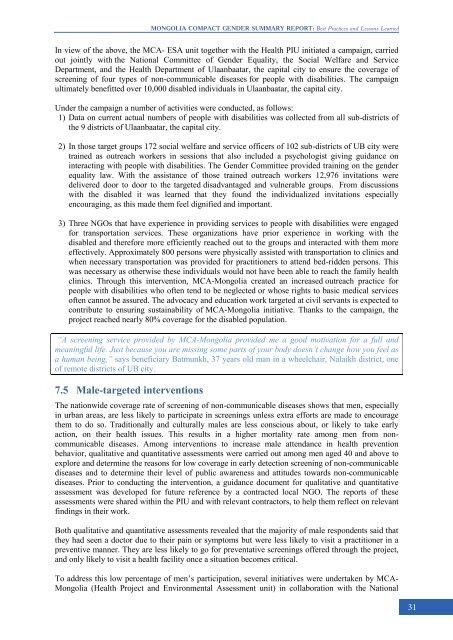Ulaanbaatar 2013
Ulaanbaatar 2013
Ulaanbaatar 2013
Create successful ePaper yourself
Turn your PDF publications into a flip-book with our unique Google optimized e-Paper software.
Mongolia Compact Gender Summary Report: Best Practices And Lessons LearnedIn view of the above, the MCA- ESA unit together with the Health PIU initiated a campaign, carriedout jointly with the National Committee of Gender Equality, the Social Welfare and ServiceDepartment, and the Health Department of <strong>Ulaanbaatar</strong>, the capital city to ensure the coverage ofscreening of four types of non-communicable diseases for people with disabilities. The campaignultimately benefitted over 10,000 disabled individuals in <strong>Ulaanbaatar</strong>, the capital city.Under the campaign a number of activities were conducted, as follows:1) Data on current actual numbers of people with disabilities was collected from all sub-districts ofthe 9 districts of <strong>Ulaanbaatar</strong>, the capital city.2) In those target groups 172 social welfare and service officers of 102 sub-districts of UB city weretrained as outreach workers in sessions that also included a psychologist giving guidance oninteracting with people with disabilities. The Gender Committee provided training on the genderequality law. With the assistance of those trained outreach workers 12,976 invitations weredelivered door to door to the targeted disadvantaged and vulnerable groups. From discussionswith the disabled it was learned that they found the individualized invitations especiallyencouraging, as this made them feel dignified and important.3) Three NGOs that have experience in providing services to people with disabilities were engagedfor transportation services. These organizations have prior experience in working with thedisabled and therefore more efficiently reached out to the groups and interacted with them moreeffectively. Approximately 800 persons were physically assisted with transportation to clinics andwhen necessary transportation was provided for practitioners to attend bed-ridden persons. Thiswas necessary as otherwise these individuals would not have been able to reach the family healthclinics. Through this intervention, MCA-Mongolia created an increased outreach practice forpeople with disabilities who often tend to be neglected or whose rights to basic medical servicesoften cannot be assured. The advocacy and education work targeted at civil servants is expected tocontribute to ensuring sustainability of MCA-Mongolia initiative. Thanks to the campaign, theproject reached nearly 80% coverage for the disabled population.“A screening service provided by MCA-Mongolia provided me a good motivation for a full andmeaningful life. Just because you are missing some parts of your body doesn’t change how you feel asa human being,” says beneficiary Batmunkh, 37 years old man in a wheelchair, Nalaikh district, oneof remote districts of UB city.7.5 Male-targeted interventionsThe nationwide coverage rate of screening of non-communicable diseases shows that men, especiallyin urban areas, are less likely to participate in screenings unless extra efforts are made to encouragethem to do so. Traditionally and culturally males are less conscious about, or likely to take earlyaction, on their health issues. This results in a higher mortality rate among men from noncommunicablediseases. Among interventions to increase male attendance in health preventionbehavior, qualitative and quantitative assessments were carried out among men aged 40 and above toexplore and determine the reasons for low coverage in early detection screening of non-communicablediseases and to determine their level of public awareness and attitudes towards non-communicablediseases. Prior to conducting the intervention, a guidance document for qualitative and quantitativeassessment was developed for future reference by a contracted local NGO. The reports of theseassessments were shared within the PIU and with relevant contractors, to help them reflect on relevantfindings in their work.Both qualitative and quantitative assessments revealed that the majority of male respondents said thatthey had seen a doctor due to their pain or symptoms but were less likely to visit a practitioner in apreventive manner. They are less likely to go for preventative screenings offered through the project,and only likely to visit a health facility once a situation becomes critical.To address this low percentage of men‟s participation, several initiatives were undertaken by MCA-Mongolia (Health Project and Environmental Assessment unit) in collaboration with the NationalPage 31 of 8031


